Highly talent people sat in all sorts of posts, but they were people who wanted to rule without being able to serve.
- Hermann Hesse, The Glass Bead Game
What is servant leadership—and what is it not?
Good question—I’ll start by illustrating the answer with a real example.
A good friend of mine once described to me how he sat with his team several years ago listening to a presentation by his company’s CEO (let’s call him Joe).
Joe was new to the position but came with an impressive set of leadership credentials. The vibe in the room was energetic and positive, and everyone was excited to hear what Joe had to say.
They were all thinking the same thing: that a fresh leadership approach was exactly what the company needed to take things to the next level.
My friend’s hopes were quickly dashed, however, when Joe began sharing his philosophy on the responsibilities of employees. He talked about a “Virtuous cycle” of business that started with employees taking care of shareholders.
According to Joe, the top priority of employees—their ultimate mission and goal—was to “Exceed shareholder expectations”.
He went on to explain that if shareholders were happy, they would invest more, enabling the company to take better care of its customers. And, if customers were happy, the company would make money, and the cycle would end with employees being taken care of.
His philosophy looked something like this:
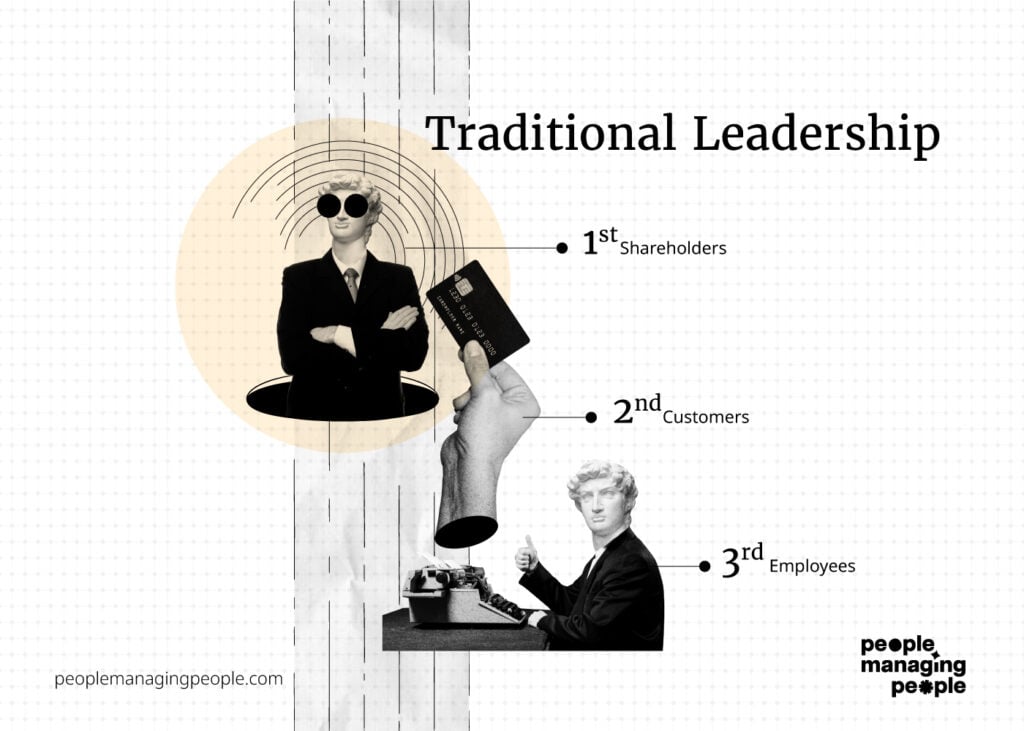
It was a shock to my friend’s system.
My friend explained to me how the culture of the organization under the previous leadership had always been “employees first”.
The role of a leader was to create the vision and values, coach and develop team members, and support their success. They believed that motivated and productive employees would deliver the best possible customer experience, yielding “raving fans” of the company’s products and services.
In my friend’s opinion, the “virtuous cycle” ended with shareholders reaping the rewards of happy, paying customers.
What my friend was describing is servant leadership. His philosophy looked like this:
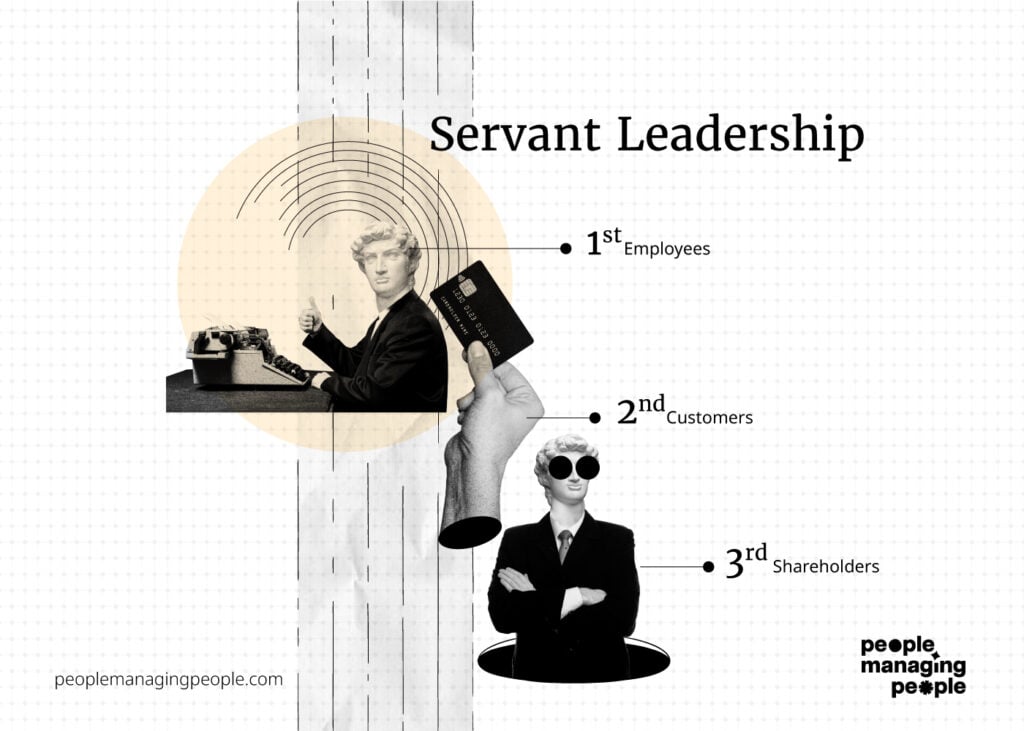
The difference between these two philosophies is night and day, and it has deep repercussions on a company’s culture that permeate through every level of management. Servant leadership is a make-or-break practice.
If you do a web search for “servant leadership” you’ll find plenty of theoretical guidance, but what does it really take to practice this form of leadership?
So, what is servant leadership and how do your practice it?
This article is written for people in management and leadership roles looking to understand servant leadership on both a theoretical and a practical level. Drawing from real-life examples of servant leadership, we’ll help you understand:
- The Basics Of Servant Leadership
- Traditional Vs. Servant Leadership Style
- Myths And Misconceptions Of Servant Leadership
- Becoming A Servant Leader: From Theory To Practice
- Daily Habits And Behaviours Of Successful Servant Leaders
- Creating A Workplace Culture Of Servant Leadership
- Measuring The Success Of Servant Leadership
Let's dive in.
What Is Servant Leadership?
Servant leadership is a type of leadership that puts employees first. Organizations with a servant leadership culture believe that if employees are cared for and put first, those same employees will be highly motivated to create loyal and satisfied customers.
First conceptualized by Robert K. Greenleaf in the 1970s, servant leadership has become more prominent as a corporate leadership philosophy in the last few decades.
Today, many of our greatest thought leaders on the subject of leadership—people like Simon Sinek, Patrick Lencioni, and Brene Brown—speak often about the power of servant leadership to create healthy, high-performing workplace cultures.
So, what are some of the characteristics of servant leadership and a servant leader?
A servant leader focuses first on the growth and well-being of their employees, as a means of achieving success for customers, shareholders, and themselves.
When you look after your employees they're more engaged, and more engaged employees results in happier customers, ultimately delivering value to the shareholders.
The Differences Between Traditional And Servant Leadership
How is traditional leadership different from servant leadership?
The differences between these leadership styles originate from the priorities we covered in my previous example:
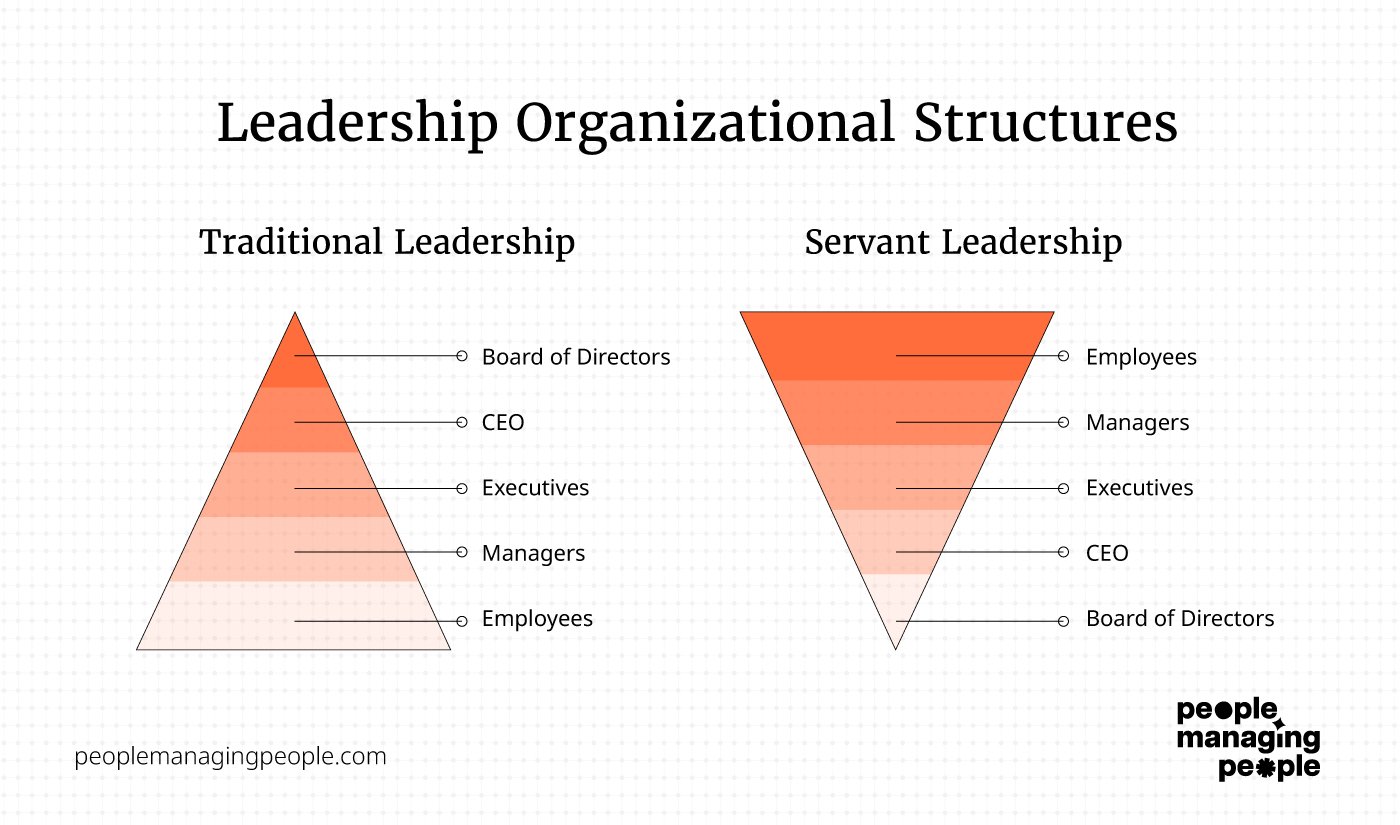
Like traditional leaders, servant leaders will create a vision and values for the organization. They will set goals and objectives for team members to achieve. Servant leaders, however, share power with team members to enable them to achieve the vision, live the values, and hit the goals.
Unlike traditional leaders, servant leaders use their power to:
- Empower more and micromanage less;
- Coach more and direct less;
- Involve more and exclude less;
- Ask questions more and assume less; and
- Listen more and talk less.
Traditional leaders will rely on their position to control e.g. “You will do as I say because I’m your manager”.
A traditional organizational structure would typically look like the traditional leadership pyramid illustrated above. If you asked a servant leader to draw their org structure, however, it would look quite different, the reverse of a traditional structure.
According to Blanchard, “Too many leaders have been conditioned to think of leadership only in terms of power and control. But there is a better way to lead—one that combines equal parts serving and leading.”
In times of crisis, a servant leader focuses on the needs of employees before the needs of themselves or shareholders.
Amidst the current COVID-19 pandemic, Ed Bastien, CEO of Delta Airlines and a believer in the “virtuous circle” of servant leadership, announced that he would be taking a 100% pay cut for six months during the crisis. COVID-19 highlighted the work of many servant leaders like Bastien who put their people first.
Myths And Misconceptions Of Servant Leadership
People unfamiliar with the servant leadership style might focus on the word “servant” and think of a butler, dutifully serving his lord and master with total obedience. The butler is beneath his employer, and he does as he’s asked, without question. It’s therefore natural for some corporate leaders to reject the concept out-of-hand, thinking that by adopting a servant leadership approach they must become the butler, give up all their power, and let their employees run the company.
However, this is NOT servant leadership. Following are just a few of the myths and misconceptions about servant leadership.
Myth #1: Servant leadership means giving up power to employees.
Servant leadership is about sharing power and decision-making with employees to enable the business to be successful.
Kim Savage, the Executive Director for Hope International, a non-profit agency based in New Westminster, BC, has lived her life following the servant leadership philosophy. She explains:
"Servant leadership doesn’t mean that employees can do whatever they want, or that every decision within the organization is made by consensus." - Kim Savage, ED of Hope International.
Instead, servant leaders empower their people, train and coach them on how to use that power, and hold them accountable for their actions and decisions. They also work to understand what their people are capable of and realize that some individuals may need more coaching and support than others.
Myth #2: A servant leader is abdicating responsibility for success.
A servant leader understands that they are ultimately responsible for the success of their employees and the success of their business. If an organization’s goals and objectives aren’t met, a servant leader will look first at themselves and what they could have done better to support their people in achieving them.
According to Savage, “sometimes decisions need to be made that only the leader can make; the tough calls that might be unpopular.” But she also notes that “a servant-led organization will also be able to weather those moments with a lot more trust and adaptability than a traditional one.”
Myth #3: Servant leaders don’t care about customers or shareholders.
Some people think that because servant leaders focus first on the needs and interests of their employees, they don’t care about what the business’s customers or shareholders need.
In fact, servant leaders believe the opposite: that customer and shareholder expectations can only be met (or exceeded) by creating motivated, engaged, and high-performing employees.
When Cheryl Bachelder was named CEO of Popeye’s Louisiana Kitchen in 2007, the restaurant chain was a stagnant brand and struggling financially. In her book “Dare to Serve”, Bachelder tells the story of how she worked to create a servant leadership culture at Popeyes as a means to reverse the company’s fortunes. She was successful. By the time Popeyes sold for $1.8B to Restaurant Brands International (owner of Burger King and Tim Hortons), the company’s sales and profits were up; market share had increased, and franchisees and customers were happier than ever before
Becoming A Servant Leader: Moving From “I” To “We”
At its core, becoming a servant leader involves moving from being self-serving to serving the needs others.
You might ask, “Who wouldn’t want to practice servant leadership? And what leader would want to be considered self-serving?”
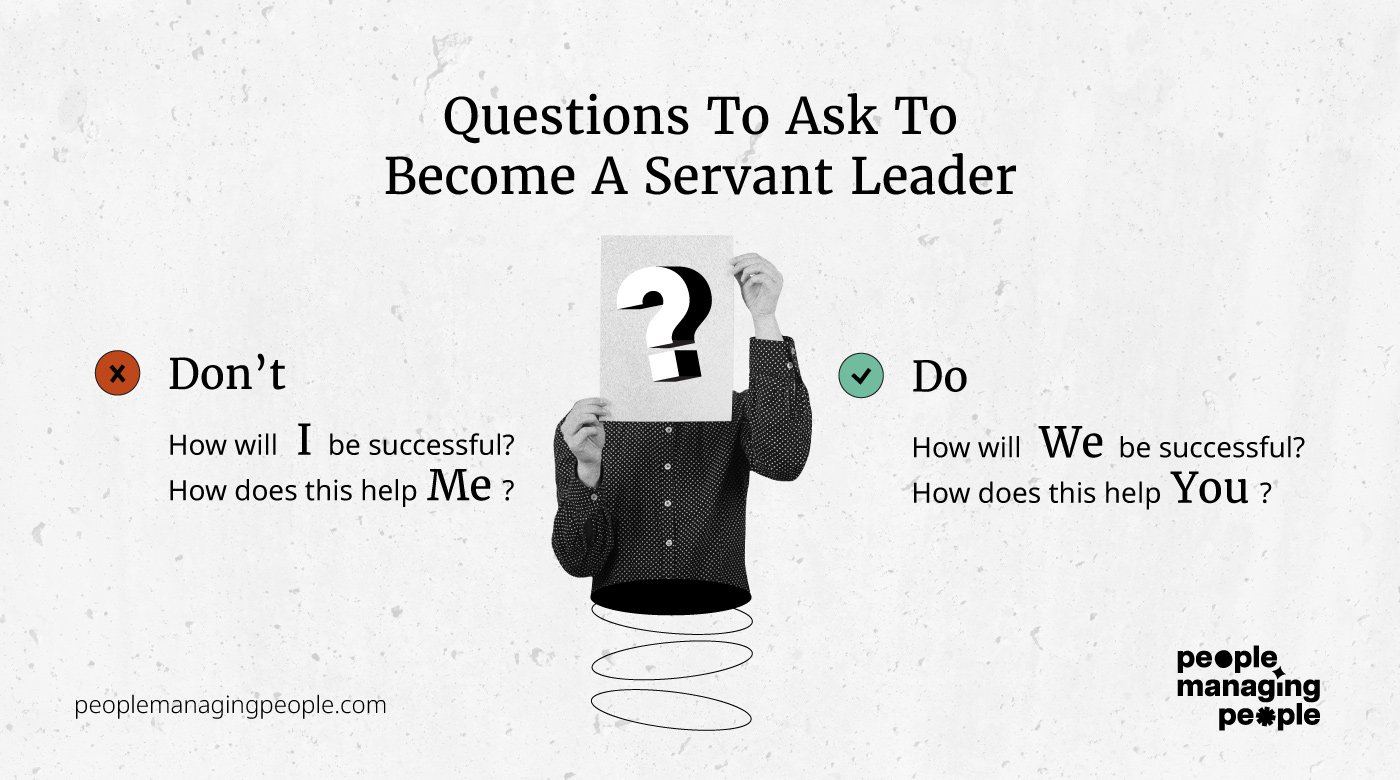
While there are clear benefits to practicing servant leadership, moving from theory into practice can be difficult. This is particularly true when we consider trying to create a servant leadership culture within an organization, which we’ll cover in the next section.
But what is that first step? Where do you begin? Leadership expert and author Stephen M.R. Covey offers us this simple advice in a 2017 Servant Leadership Institute article:
"It begins with a self-audit and a commitment. Ask yourself: What is the level of trust I share with my relationships, my team, my stakeholders? What is my real intent? Is it truly to serve others, or is it to serve myself?" — Stephen M.R. Covey, Leadership Expert
Step #1: Understand the emotional obstacles to servant leadership
Some of the biggest obstacles on the path to servant leadership are a result of our feelings, emotions, and behaviors, many of which have been ingrained in us since we were born.
Ken Blanchard, one of the champions of servant leadership, once said, “The human ego keeps people from their intention to serve.” However, it’s not always just ego that can get in the way of becoming a servant leader.
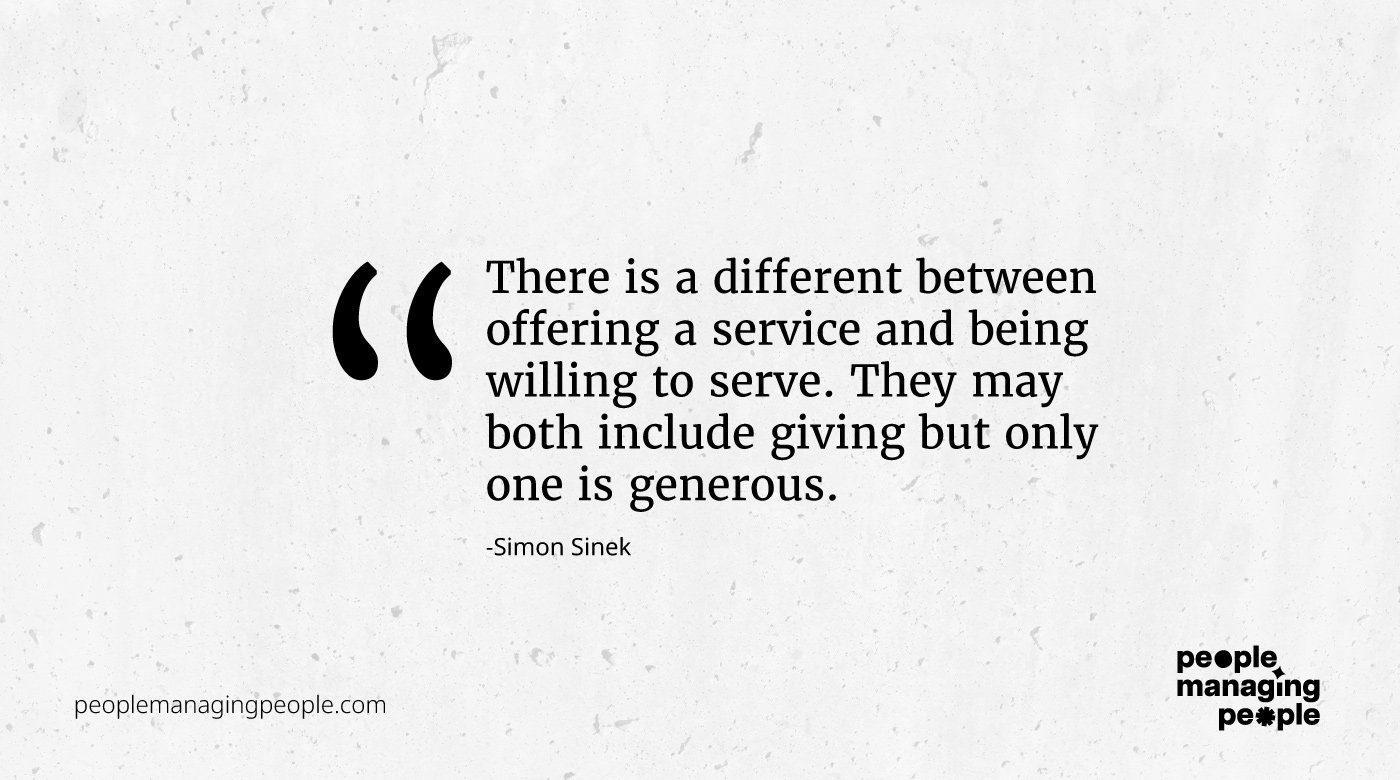
Some of the most powerful negative emotions that can hinder the journey include:
- Fear: perhaps it’s fear that our team members will make a mistake, fear that we’ll fail as a servant leader, or fear that we’ll be successful and work ourselves out of a job.
- Pride: along with the ego, pride can make us feel that by sharing power we are “less than” we were (less important, less powerful, or less needed by others).
- Arrogance: going hand-in-hand with pride, sometimes we think we’re the only ones who can do what we do, and to allow someone else to do it would invite failure.
- Self-worth: attaching our feelings of self-worth (how we feel about ourselves) to things like money, status, or job title, drives the “I” mentality.
We can further understand the emotional journey that needs to take place if we flip those feelings around and look at their positive counterparts e.g. fear vs courage.
In her contribution to the book Servant Leadership in Action, author and lecturer Brené Brown explains that servant leadership and shame culture—a culture where fear and shame motivate and drive behavior—can not coexist because “the foundation of servant leadership is courage and shame breeds fear.”
Step #2: Build self-awareness and emotional intelligence
Perhaps the most important step on the path to becoming a servant leader is to raise your own self-awareness and emotional intelligence (also known as EQ). Luckily, there are more tools than ever to help us build a better understanding of ourselves and accept servant leadership principles:
- Self-assessment tools like those from Emergenetics and TalentSmart can help us understand how we think and our overall level of emotional intelligence.
- Self-awareness and meditation apps like CheckingIn and Calm can help us become more mindful and aware of the thoughts and emotions that drive our behaviors

- Professional development and coaching from consultants and executive coaches trained in servant leadership development can help us focus and be held accountable to our goals.
Step #3: Build the right habits and behaviors
Becoming a successful servant leader often requires the breaking of “bad” habits and the development of healthy new ones.
James Clear, the author of Atomic Habits, defines habits as: “the small decisions you make and actions you perform every day.” On his website, Clear sets out a number of strategies to help do this, such as starting with an incredibly small habit and building that habit up in small steps.
For example, meditating can help build self-awareness and EQ, but rather than trying to meditate for 30 minutes, start by meditating for just a minute or two, and increase by a small amount—may be 10%—a day.
Here are some of the habits and behaviors cultivated over time by successful servant leaders:
- Make time for mindfulness: Brett Landry, a Vancouver-based entrepreneur, business consultant, and now Senior Pastor for ChristCity Church in Vancouver, suggests starting your day from a place of thoughtfulness and avoid jumping onto your phone and into task lists.
Your EQ needs to be as high as your IQ—always take stock of your emotional capacity, in whatever moment you’re in.
Brett Landry, Entrepreneur, Business Consultant & Pastor
- Take care of your health: Landry also emphasizes, “Don’t neglect your physical health, or underestimate the impact it can have on your emotional health—and vice versa.” Showing up as a servant leader, day in and day out requires strong mental and physical health and stamina.
- Continually coach: According to Garry Ridge, the CEO of WD-40, “the annual performance review process is broken. Why wait until the end of the year? Coaching, development, and feedback should be an everyday conversation between the leader and direct report.”
- Listen first, talk second: Kim Savage of HOPE International says,
Learning to speak second has been one of the hardest parts of implementing servant leadership. It’s important to allow space in the room for others to talk first, and for you to listen.
Kim Savage, HOPE International
- Do what you say you’ll do: Herb Kelleher, the former CEO of Southwest Airlines, once said, “When we give our word it’s our word, and we keep our word.” Creating a habit of making commitments and keeping them is key to developing the trust that’s required for successful servant leadership.
Creating A Servant Leadership Culture
So, you’ve worked hard to become a trusted, successful servant leader. Now what?
For a company to succeed through servant leadership requires a culture of servant leadership. This means that everyone in your organization—leaders, managers, and employees alike—must believe in the power of servant leadership as a path to business success.
This is a difficult task regardless of who you are and your level of seniority. Even if you’re the CEO of your company, understanding how to improve your workplace culture by transitioning to a servant-led one can be difficult.
Here are a few of the most important elements of a servant leadership model you can employ in your organization:
Create a clear vision and set of values

In his book “Leaders Eat Last”, author Simon Sinek says,
"A leader forges a vision for the future that the entire group feels inspired to fulfill. Although every group member has individual goals, the group as a whole needs a purpose in order to remain cohesive, and that purpose comes from the leader’s vision."
Sinek cites Microsoft co-founder Bill Gates as an example. When he started Microsoft, his goal wasn’t to make a billion-dollar company and be in charge of thousands of employees. Gates’ vision—his dream—was to put a computer on every desk.
Art Barter bought Datron World Communications in 2004 for $10M and used servant leadership to turn the company into a $200M success story in just six years.
He went on to create the Servant Leadership Institute, and in a recent article, he talked about the importance of living your values.
"It’s more than just telling your employees what you want them to do. When you present your values, you’ll have opportunities to mentor and coach. Sit with people and help them understand why you do what you do and why the values are so important. The values have to drive their behavior, and that only happens when they understand the purpose behind them." — Art Barter, CEO of Datron World Communications
Build trust and a feeling of safety
In his book Leaders Eat Last, Simon Sinek puts great emphasis on the importance of a leader’s honesty, integrity, and trust as a foundation for employees to feel safe.
It is the leader’s responsibility to create this emotional “circle of safety” around the group, and create the vision and values shared by this group.
He argues that people can trust each other within this circle, and through this trust, pool resources in order to progress.
Feeling trusted and safe is critical for employees to thrive within a servant-led organization. They must feel that they can take risks, make mistakes, and learn from them, rather than be punished for them.
When people feel safe they are willing to be vulnerable and offer their ideas and insight to their leaders, rather than hide them for fear of shame and ridicule.

Trust is both a means and an outcome of effective servant leadership.
A servant leader will trust first and assume the positive intentions of the people that work for them.
Similarly, you’ll see success as a servant leader when you’ve earned their trust in return.
Hire and grow future servant leaders
Teaching servant leadership principles, and having leaders actually believe in and practice those teachings, isn’t just a matter of running a couple of training sessions or having them read a book.
Servant leadership is a fundamental change from traditional leadership and can be a long journey for some.
At the same time, creating a culture of servant leadership requires the support of its leaders, so how do you start?
Kim Savage, the Executive Director for HOPE International, recommends that you “start with the two or three like-minded people who already have some natural ability or tendency toward servant leadership. If you can draw servant leadership out of just a few, and highlight their successes, you can start to get those who are maybe more skeptical to eventually get on board.”
Savage also emphasizes the importance of hiring people with similar values, or who have been servant leaders with other companies, as a means of ensuring alignment within the leadership team.
Cultivating a servant leadership environment requires clear and meaningful feedback mechanisms. Leveraging insightful performance appraisal phrases ensures that evaluations are both supportive and developmental, reflecting the core values of servant leadership.
Measuring success—deliver results and celebrate
As the saying goes, “the proof is in the pudding”.
It’s important to highlight the successes of servant leadership in order to reinforce the habits and behaviors required to practice it.
Showing success and praising progress also validates the principles of servant leadership and builds trust in the people practicing it. It’s also important to measure and demonstrate the power of servant leadership to customers and shareholders.
A CEO practicing servant leadership principles may not be the CEO for long if they don’t deliver results!
Those results can include:
- Financial metrics and KPIs: sales, profitability, share price, and market share are just a few of the “hard numbers” that reflect the performance of a company and its leadership.
- Employee engagement and motivation: the employee experience is central to successful servant leadership, so it’s important to ask/survey them about their level of engagement with work, trust in their leaders and co-workers, and loyalty to the company.
- Reputation and customer experience: servant leadership focuses on meeting customer needs by focusing on employees first. Customer surveys, Net Promoter Scores, and product ratings and reviews can provide insight into their experience.
Examples of servant leaders
Based on the principles of empowering, coaching, involving, listening, and asking, here are some examples of leaders whose styles could be classed as 'servant'.
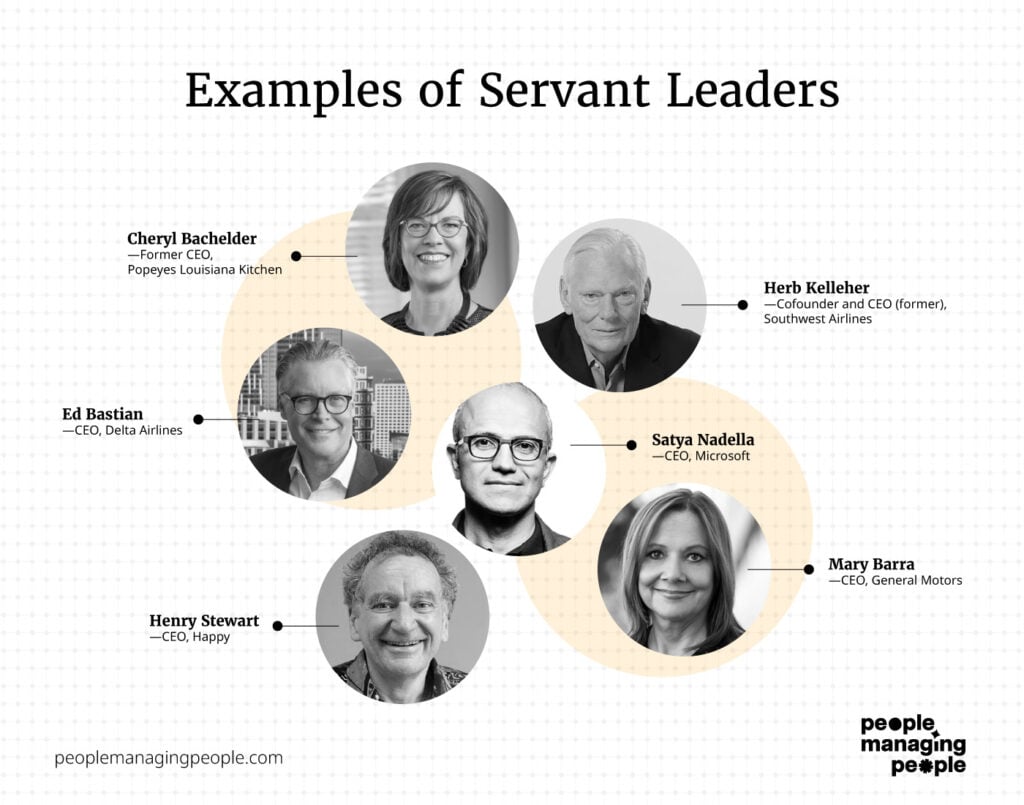
Cheryl Bachelder—Former CEO, Popeyes Louisiana Kitchen
Bachelder wrote a book called Dare To Serve that's all about servant leadership (recommended).
In it, she attributes her success in turning around the struggling food chain to fostering a servant leadership culture based on getting to know people, empowering them, setting a bold vision, and providing an environment for personal growth.
Herb Kelleher—Cofounder and CEO (former), Southwest Airlines
A self-made billionaire from humble origins, Kelleher built his company from the ground up.
His philosophy was that “The business of business is People" and the company's definition of culture is "The development, improvement, and refinement of the originality, individuality, identity, and personality of a given people."
There are many stories of Kelleher helping baggage handlers during the holiday period and bringing engineering teams donuts at 4 am.
Ed Bastian—CEO, Delta Airlines
Bastian sits at number 8 of the top-rated CEOs on Glassdoor (a platform on which employees can rate their companies and leadership).
When interviewed about his leadership style, he always emphasizes that his primary concern as CEO is his people.
"One of the most important things, if not the most important thing, I do is spend quality time with our people—not just at the management level, but with our frontline personnel."
Satya Nadella—CEO, Microsoft
Number 6 on the list of top-rated CEOs, Nadella is lauded for turning around the once-flailing tech giant.
A primary way he's achieved this is by putting his people first. When he first became CEO, he devoted much of his first year to listening to employees at all levels where he was disheartened to discover how little time managers spent coaching their employees.
Microsoft's framework is called 'Model, Coach and Care and is geared to fostering a growth mindset where employees are supported and listened to.
Mary Barra—CEO, General Motors
Barra began her career at General Motors as an engineer on the factory floor, giving her a deep knowledge of the company and its people.
When she took over as CEO the company was in a slump in mired in a PR crisis. To turn things around, Barra scrapped a lot of corporate red tape and supported and empowered workers to make decisions, for example shortening the famous 10-page dress code document to two words.
“If you work hard, and you care about people and you have passion in what you do, you’ll do well.” — Mary Barra
Henry Stewart—CEO, Happy
In most organizations, employees don't know how much their CEO earns let alone have a say in how much they earn. But Stewart wanted to determine how much value employees thought he was adding to the company so, for the last two years, he let his employee vote on his annual pay rise.
Servant Leadership Will Make You A More Successful Leader
The examples above, as well as many more, prove that servant leadership results in the growth of more successful teams and organizations.
You, as the leader, play a crucial part in that journey. For further inspiration, take a read of some of these servant leadership books.
You can also subscribe to the newsletter to get updates when we publish fresh articles and podcasts with the latest thinking in HR from leadership and management experts from around the world.





